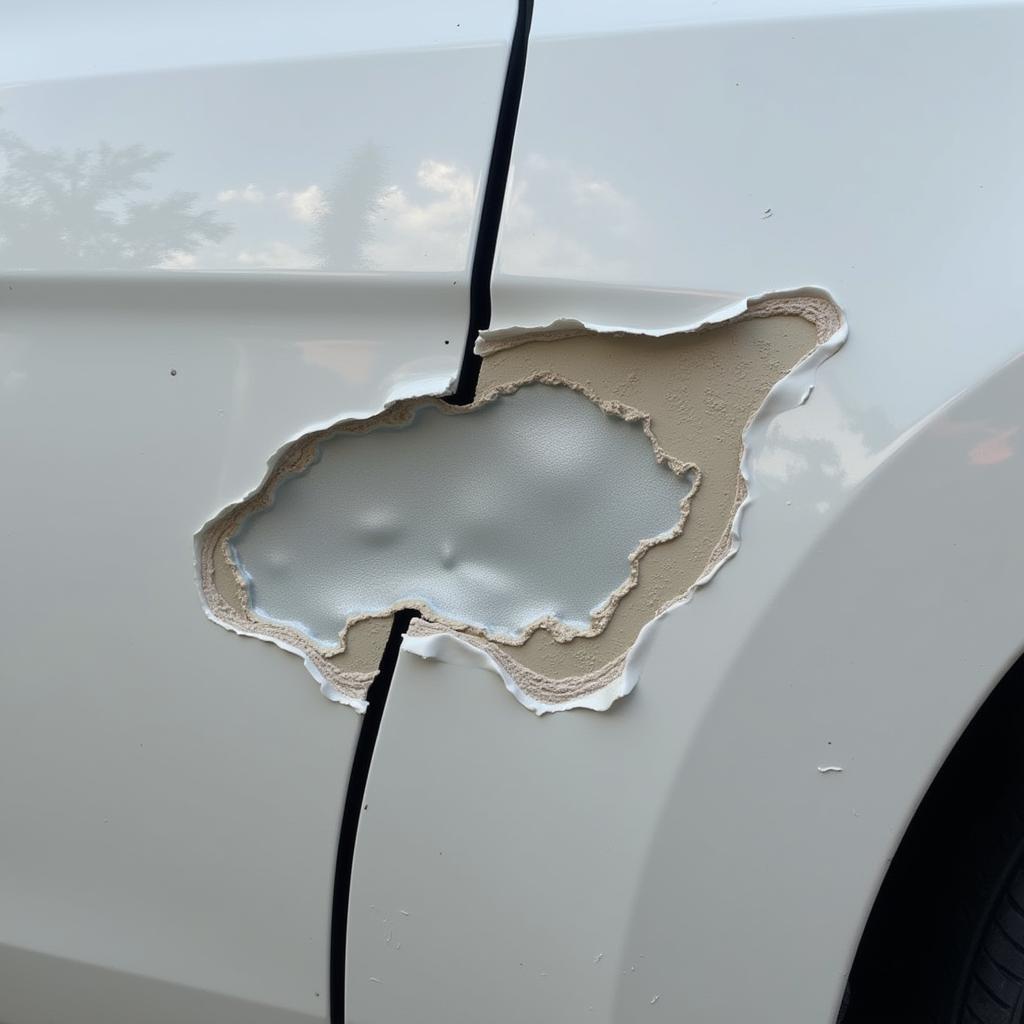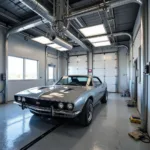Car paint peeling after repair is a frustrating issue that can leave car owners feeling cheated and disheartened. It signals a problem with the repair process and can detract from the car’s appearance. Understanding the causes and solutions for this problem can help you avoid it in the future and know what steps to take if you’re currently dealing with peeling paint.
Peeling paint doesn’t just look bad; it can also expose the underlying metal to the elements, leading to rust and further damage. This article will delve into the common reasons why car paint peels after a repair, how to diagnose the issue, and what steps you can take to rectify the situation. We’ll cover everything from improper surface preparation to environmental factors and provide practical advice for preventing this problem. You can learn more about how to address faded or peeling paint in our guide on how to repair faded peeling paint on car.
Common Causes of Car Paint Peeling After Repair
Several factors can contribute to car paint peeling after a repair. Identifying the underlying cause is crucial for implementing the correct solution.
- Improper Surface Preparation: This is the most common culprit. If the surface wasn’t properly cleaned, sanded, and primed before the new paint was applied, adhesion issues can arise, leading to peeling. Contaminants like dirt, grease, or old wax can prevent the new paint from bonding properly.
- Incompatible Paint Products: Using incompatible primers, base coats, or clear coats can create a chemical reaction that causes the paint to lift and peel. Always ensure the products used are designed to work together.
- Incorrect Paint Application: Applying the paint too thickly or too thinly, or not allowing sufficient drying time between coats, can also lead to peeling. Each paint type has specific application requirements that must be followed.
- Moisture: Trapped moisture beneath the paint layer can create pressure, causing the paint to blister and eventually peel. This is especially common in areas prone to high humidity or if the car was recently washed before the repair.
- Low-Quality Paint: Using low-quality paint can also contribute to peeling. These paints often lack the necessary binders and resins for proper adhesion and durability.
- Environmental Factors: Exposure to harsh weather conditions, such as extreme heat, cold, or UV radiation, can weaken the paint and make it more susceptible to peeling.
Diagnosing the Problem
Diagnosing the cause of peeling paint requires careful observation. Look for patterns in the peeling. Is it localized to a specific area, or is it widespread? Is the peeling occurring between layers of paint, or is the entire paint system lifting from the substrate? Checking for underlying rust can also provide clues about moisture issues. You may even want to consult a professional for a more in-depth assessment. For small chips, there are specific repair methods you can explore, as detailed in our guide on how to repair small paint chips car down to metal.
Solutions for Car Paint Peeling After Repair
Once you’ve identified the cause, you can take steps to fix the problem. For minor peeling, sanding the affected area and applying a new coat of paint might be sufficient. However, for more extensive peeling, a complete stripping and repainting of the affected panel might be necessary. This is often best left to professionals, especially if the issue stems from improper surface preparation or incompatible paint products. If rust is present, it needs to be treated before repainting. You can find a reputable shop using our directory of car rust repair and paint shop locations.
Preventing Car Paint Peeling
Prevention is always better than cure. Here are some tips to prevent car paint peeling after a repair:
- Choose a Reputable Repair Shop: A qualified and experienced auto body shop will use high-quality paint products and follow proper procedures to ensure a durable and long-lasting finish.
- Ensure Proper Surface Preparation: Thorough cleaning, sanding, and priming are essential for proper paint adhesion.
- Use Compatible Paint Products: Ensure all paint products used are compatible with each other to avoid chemical reactions.
How to Choose the Right Car Paint
Choosing the right car paint is crucial for a successful repair. Opt for high-quality automotive paint from reputable brands. Consider the type of paint (acrylic lacquer, acrylic enamel, or urethane) and ensure it’s compatible with the existing paint and primer. If you’re unsure, consult with a paint specialist or your chosen repair shop. You might also find our guide on car paint faded repair helpful.
Maintaining Your Car’s Paint Job
Proper maintenance can extend the life of your car’s paint job and prevent peeling. Regularly wash and wax your car to protect it from environmental contaminants and UV radiation. Avoid parking under trees or in direct sunlight for extended periods. Addressing minor chips and scratches promptly can prevent them from developing into larger problems. For touch-ups, you can use specialized car leather repair paint for leather surfaces.
Conclusion
Car paint peeling after repair is a preventable problem. By understanding the causes and implementing proper repair and maintenance practices, you can keep your car looking its best for years to come. Addressing the issue early and choosing a qualified repair shop are key to achieving a long-lasting and beautiful paint job. Remember, proper surface preparation is crucial for preventing future peeling.
FAQ
- How long should car paint last after a repair? A quality paint job, when properly maintained, can last for several years.
- Can I fix peeling car paint myself? Minor peeling can sometimes be addressed with DIY methods, but extensive peeling often requires professional expertise.
- What is the best way to prevent car paint from peeling? Proper surface preparation, using high-quality paint products, and regular maintenance are key.
- How do I choose a reputable car repair shop? Look for certified shops with positive reviews and experience in car painting.
- Is it necessary to prime before painting a car? Yes, priming is crucial for proper paint adhesion and durability.
- What type of paint is best for car repairs? Urethane paints are generally considered the most durable and long-lasting.
- How long does it take for car paint to fully cure? The curing time varies depending on the type of paint and environmental conditions, but it can take several weeks for the paint to fully harden.
Need more information? Check out our other articles on car repair and maintenance.
For immediate assistance, please contact us via WhatsApp: +1(641)206-8880 or Email: [email protected]. Our customer service team is available 24/7.



